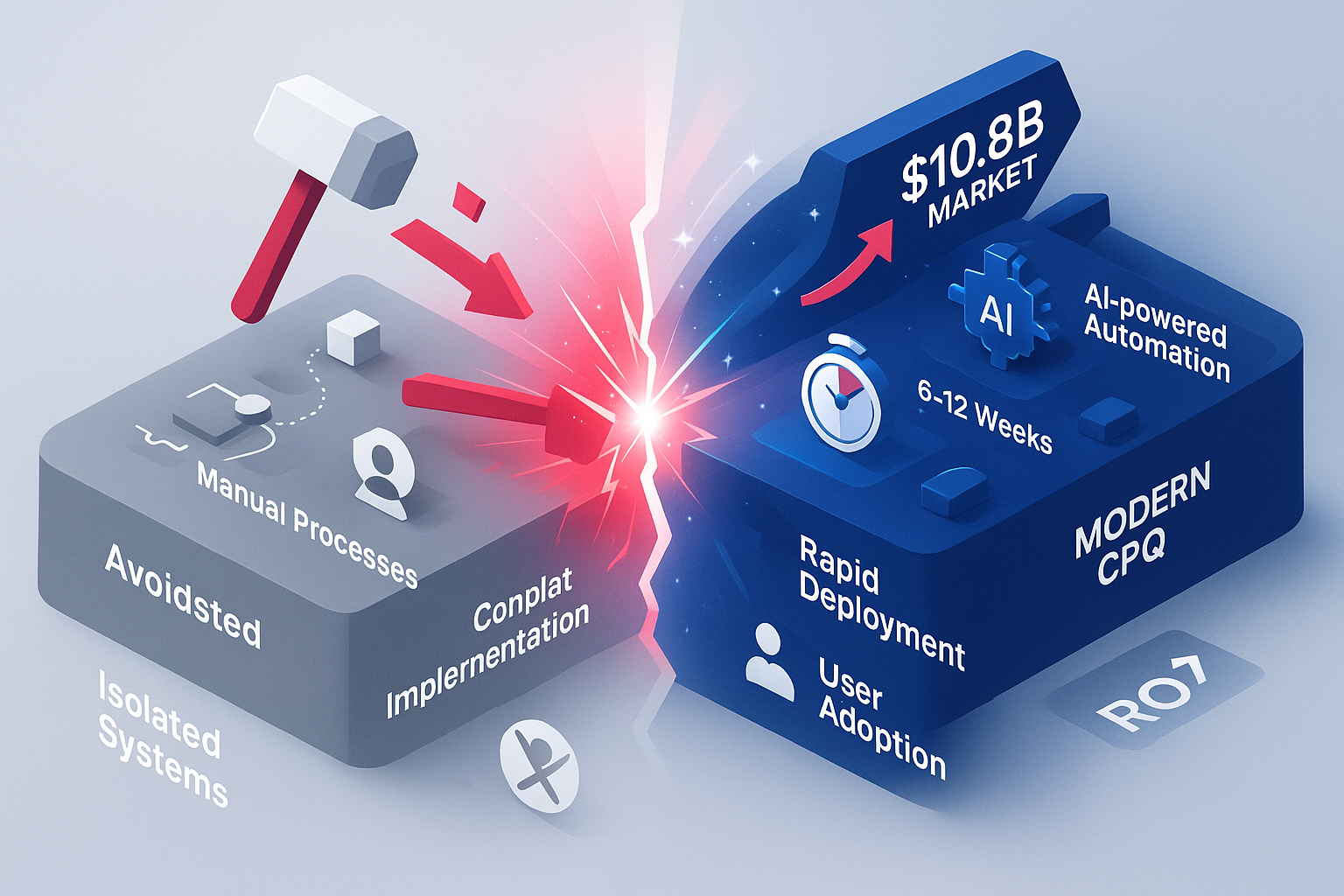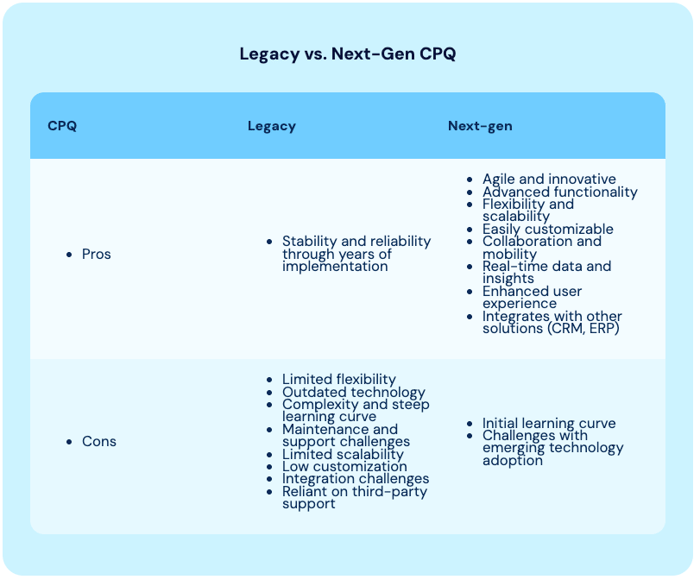10 CPQ Software Myths Debunked: The Complete 2025 Guide

Think CPQ (Configure, Price, Quote) solutions are outdated tech or becoming obsolete? Think again. With recent major shifts like Salesforce CPQ's end-of-sale, myths about CPQ are more prevalent than ever. Let's debunk the most common misconceptions with current market realities.
The Current CPQ Landscape: Separating Fact from Fiction
Recent market developments have created new confusion about CPQ solutions:
- Salesforce CPQ End-of-Sale (March 2025) [Salesforce Ben, 2025]: Leading businesses to question CPQ viability
- AI Integration: Revolutionary changes in pricing automation and configuration
- Market Growth: Projected growth despite enterprise platform shifts
TABLE OVERVIEW
- CPQ Solutions are Becoming Obsolete
- CPQ Requires Extensive Technical Expertise
- CPQ is Too Expensive for Mid-Market Companies
- CPQ Eliminates the Need for Sales Professionals
- CPQ Offers Generic, One-Size-Fits-All Solutions
- CPQ Systems Operate in Isolation
- CPQ Implementation Disrupts Operations
- CPQ Only Works for Simple Products
- CPQ Can't Handle Service-Based Offerings
- Sales Teams Resist CPQ Technology
Additional Sections:
Myth 1: CPQ Solutions are Becoming Obsolete with Salesforce CPQ's End-of-Sale
The Reality: The CPQ market is experiencing unprecedented growth despite platform transitions:
- Market Expansion: The global CPQ market reached $3 billion in 2024 and is projected to hit $10.8 billion by 2033 [Business Research Insights, 2025]
- Platform Evolution: While Salesforce CPQ entered end-of-sale in Q1 2025 [Salesforce Ben, 2025], alternatives like DealHub, Revenue Cloud Advanced, and PROS are thriving
- Success Metrics: 26% more sales representatives meet their quota when using CPQ software compared to manual processes [Axanom Inc via LLCBuddy, 2025]
Myth 2: CPQ Implementation Requires Extensive Technical Expertise and Months of Setup
The Reality: Modern CPQ platforms prioritize user experience and rapid deployment:
- No-Code Configuration: Platforms offer visual, drag-and-drop setup capabilities
- Implementation Speed: Mid-market companies typically implement CPQ in 6-12 weeks [Industry average]
- Guided Workflows: AI-powered interfaces walk users through complex configurations
- Template Libraries: Pre-built industry templates accelerate setup
Myth 3: CPQ Solutions are Too Expensive and Only Justify ROI for Large Enterprises
The Reality: CPQ solutions now serve businesses of all sizes with flexible pricing:
- Scalable Pricing: Starting packages available for 10-seat implementations
- ROI Timeline: Most organizations see positive ROI within 6-12 months [Aberdeen Group, 2017]
- Hidden Cost Savings: Automated pricing reduces errors that typically impact revenue
- Mid-Market Focus: Solutions specifically designed for mid-market companies
Myth 4: CPQ Automation Eliminates the Need for Skilled Sales Professionals
The Reality: CPQ enhances human capabilities rather than replacing them:
- Time Liberation: Sales reps gain more active selling time by automating administrative tasks
- Enhanced Expertise: Guided selling helps reps navigate complex product configurations confidently
- Relationship Focus: Automation handles calculations, freeing reps to build customer relationships
- Performance Boost: CPQ users achieve faster response times to customers and higher win rates [DealHub customer data]
Myth 5: CPQ Platforms Offer Generic Solutions That Don't Adapt to Business Needs
The Reality: Modern CPQ solutions are highly customizable and industry-specific:
- Industry Specialization: Dedicated solutions for manufacturing, technology, healthcare, and services
- Custom Workflows: Configurable approval processes, pricing rules, and document generation
- API-First Architecture: Integration with existing ERP, CRM, and e-commerce systems
- Multi-Currency Support: Global businesses operate across regions with localized pricing
Myth 6: CPQ Systems Operate in Isolation from Other Business Systems
The Reality: Modern CPQ solutions are integration powerhouses:
- CRM Connectivity: Native integration with HubSpot, Salesforce, and Microsoft Dynamics
- ERP Synchronization: Real-time data flow with SAP, Oracle, and other enterprise systems
- E-commerce Integration: Consistent pricing across sales channels
- API Ecosystem: Extensive integration capabilities available
Myth 7: CPQ Implementation Requires Dedicated IT Teams and Disrupts Operations
The Reality: Modern implementation methodologies minimize resource requirements:
- Phased Rollouts: Start with core functionality, expand gradually
- Change Management: Comprehensive training and adoption support included
- Cloud Deployment: No infrastructure requirements or IT maintenance
- Expert Partners: Certified implementation partners handle technical complexity
- Multi-Channel Support: CPQ extends beyond B2B to B2C applications like automotive configurators, electronics customization, and self-service portals
Myth 8: CPQ Works Only for Simple Products with Basic Pricing Models
The Reality: CPQ excels at managing complexity:
- Constraint-Based Configuration: Handles products with thousands of options and dependencies
- Dynamic Pricing: Manages tiered, volume, usage-based, and subscription pricing models
- Multi-Level Bundling: Complex product and service combinations
- Engineering Integration: Connects with CAD systems and technical specifications
Myth 9: CPQ Can't Handle Service-Based Offerings or Professional Services
The Reality: Service industries extensively use CPQ for:
- Professional Services: Time-based pricing, resource allocation, project scoping
- Subscription Services: Recurring revenue models, usage tracking, billing automation
- Bundled Offerings: Product + service combinations with complex pricing
- Consulting Packages: Customizable service levels and pricing tiers
Myth 10: Sales Teams Resist CPQ Technology and Prefer Manual Processes
The Reality: User experience design prioritizes sales team adoption:
- Intuitive Interfaces: Consumer-grade UX designed for non-technical users
- Mobile Optimization: Full functionality on tablets and smartphones for field sales
- Guided Workflows: Step-by-step processes that reduce training requirements
- Performance Incentives: Faster quoting translates to more deals and higher commissions
The 2025 CPQ Landscape: What's Changed
Major Market Developments:
- Salesforce CPQ Transition: End-of-sale creates opportunities for specialized platforms [Salesforce Ben, 2025]
- AI Integration: Machine learning transforms pricing optimization and configuration assistance
- API-First Architecture: Better integration capabilities with modern tech stacks
- Industry Specialization: Purpose-built solutions for specific verticals
Emerging Trends:
- Conversational AI: Voice-activated quote generation and modification
- Predictive Analytics: AI-powered pricing recommendations based on market data
- Headless Commerce: CPQ engines powering multiple customer touchpoints
- Real-Time Integrations: Instant synchronization with ERP and inventory systems
Choosing the Right CPQ Solution in 2025
Key Evaluation Criteria:
- Integration Capabilities: Native connectivity with your CRM and ERP systems
- Implementation Speed: Time-to-value for your organization size
- Scalability: Ability to grow with your business complexity
- Industry Fit: Specialized features for your sector
- Support Ecosystem: Partner network and ongoing support quality
Leading CPQ Platforms to Consider:
- DealHub: AI-powered solution gaining momentum in fast-growth and SaaS environments with smart AI assistants and rapid deployment
- Oracle CPQ: Advanced configurability, AI pricing insights, multi-currency/global support, and seamless integration with Oracle's ERP/CRM stack.
- SAP CPQ: Natural fit for organizations in the SAP ecosystem with powerful rule-based configuration and deep ERP/CRM links.
- Conga CPQ(formerly Apttus): Known for flexibility, guided selling, unified CPQ–CLM–billing architecture, and strong configurability.
- PROS Smart CPQ: Niche powerhouse in pricing optimization for manufacturing or complex pricing environments with AI pricing engine.
Additional Insights from DealHub
For more in-depth information on common misconceptions about CPQ solutions and how they can be effectively addressed, check out DealHub's comprehensive blog post: Legacy vs. next-gen CPQ: upgrade or fall behind
DealHub's blog delves deeper into myths about CPQ solutions such as:
-
My Sales Team Will Never Adopt It
-
It Will Just Add More Work for My Sales Team
-
We Don’t Need a CPQ – Our Quotes and Configurations are Too Simple
-
Our Solutions are Too Complex for a CPQ
-
CPQ is Too Resource-Intensive for Us to Implement and Manage

Source: Dealhub
Conclusion: CPQ in 2025 and Beyond
CPQ solutions have evolved far beyond basic quoting tools. Modern platforms combine AI-powered intelligence, seamless integrations, and user-friendly design to accelerate revenue operations for businesses of all sizes.
The key insight for 2025: organizations avoiding CPQ due to outdated misconceptions are putting themselves at a competitive disadvantage. With the CPQ market growing 17-20% annually and new platforms offering rapid implementation and proven ROI, the question isn't whether to implement CPQ—it's which solution fits your specific needs.
Next Steps:
- Assess Your Current Process: How much time does quote generation consume?
- Evaluate Integration Needs: Which systems require connectivity?
- Define Success Metrics: What ROI targets justify investment?
- Explore Options: Request demos from platforms that fit your criteria

